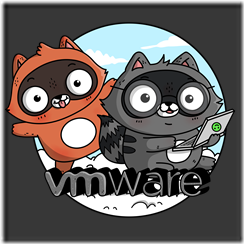Virtualization in pictures for children-snowflakes
On the third day in one community (VsSupport, if anyone cares) an unprecedented drama erupted - it turns out that knowledge from the community may be lost !!! And all for why - because the millennials (the new reincarnation of indigo children) do not know how to lead the letters themselves, and it’s difficult to search in Google.
According to the discussion of “where the world is heading”, this article was born on getting started with VMware.

Getting Started with VMware and Baby Errors
For some reason I don’t understand, when working with Vmware, and more precisely with ESXi and WS, people begin to discuss theory in isolation from practice. The theory includes both a discussion of the type of hypervisor (the first, second, not the first, but also not the second, not the hypervisor at all, and so on), and its impact on performance. An example of such an article is here , and in the article they forgot about one thing (Xen, Virtual PC), did not mention the other at all (Protection ring).
Practice, however, is far enough from this part of the theory, and, first of all, requires verification of completely different things.
So, if you had to get to work, where:
So you have only one week to prepare the work, and one weekend to check the following things in the VMware part (without considering backups, the status of the servers themselves, disks, and so on - as described in a recent excellent article . This:
- IP, logins and passwords from BIOS and IPMI ( iDrac, iLo, IMM, RMS iBMC )
- IP, logins and passwords from the VMware hosts themselves
As they write in VsSupport,
"The passwords (or rather their hashes) of ESXi users are stored in the etc / shadow file, which is stored in the local.tgz archive, which is stored in the state.tgz archive.
There are two of them on different sections sda5 \ sda6 "
or you have to read a lot of foreign letters - Changing a forgotten root password on an ESX / ESXi host (1317898)
- Server performance settings in the BIOS
As it turned out, for many it is a revelation that the modern server of any company is green and flat , therefore it is able to arrange an extremely vile move - for example, to reduce performance at times by disconnecting one power supply.
- Checking the placement of ESXi scratch partition according to the article
- And finally, preparation for installing at least ESXi patches on the list
PS The note was written under the impression of a question in the community “Do I need to connect the IPMI port to the network port on the server itself” and complaints that the native basic support VMware is expensive and the level of friendliness of support for the torrent-edition in the VsSupport community is clearly low.
Raccoons taken here
According to the discussion of “where the world is heading”, this article was born on getting started with VMware.

Getting Started with VMware and Baby Errors
For some reason I don’t understand, when working with Vmware, and more precisely with ESXi and WS, people begin to discuss theory in isolation from practice. The theory includes both a discussion of the type of hypervisor (the first, second, not the first, but also not the second, not the hypervisor at all, and so on), and its impact on performance. An example of such an article is here , and in the article they forgot about one thing (Xen, Virtual PC), did not mention the other at all (Protection ring).
Practice, however, is far enough from this part of the theory, and, first of all, requires verification of completely different things.
So, if you had to get to work, where:
- there is VMware ESXi, vCenter and many other scary words
- no documentation, logins, passwords, backups and nothing at all
- you could not find an article that has no analogues: Actions when you come to work - taking things up, updating, documenting, auditing
So you have only one week to prepare the work, and one weekend to check the following things in the VMware part (without considering backups, the status of the servers themselves, disks, and so on - as described in a recent excellent article . This:
- IP, logins and passwords from BIOS and IPMI ( iDrac, iLo, IMM, RMS iBMC )
- IP, logins and passwords from the VMware hosts themselves
As they write in VsSupport,
"The passwords (or rather their hashes) of ESXi users are stored in the etc / shadow file, which is stored in the local.tgz archive, which is stored in the state.tgz archive.
There are two of them on different sections sda5 \ sda6 "
or you have to read a lot of foreign letters - Changing a forgotten root password on an ESX / ESXi host (1317898)
- Server performance settings in the BIOS
As it turned out, for many it is a revelation that the modern server of any company is green and flat , therefore it is able to arrange an extremely vile move - for example, to reduce performance at times by disconnecting one power supply.
- Checking the placement of ESXi scratch partition according to the article
- And finally, preparation for installing at least ESXi patches on the list
PS The note was written under the impression of a question in the community “Do I need to connect the IPMI port to the network port on the server itself” and complaints that the native basic support VMware is expensive and the level of friendliness of support for the torrent-edition in the VsSupport community is clearly low.
Raccoons taken here
All Articles